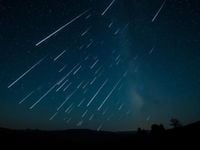For sky watchers and stargazers across the Northern Hemisphere, August 2025 promises a celestial spectacle as the annual Perseid meteor shower returns for its peak performance. Widely regarded as the most prolific space event of the year, the Perseids are set to light up the night sky between August 11 and August 13, with the most dazzling activity expected during the overnight hours of August 12 into the pre-dawn of August 13, according to FOX40.COM and The Economic Times.
The Perseid meteor shower is no ordinary display. Each summer, as Earth completes its orbit around the sun, it plows through a cosmic debris trail left by Comet 109P/Swift-Tuttle. This comet, a behemoth roughly 16 miles (26 kilometers) wide, last visited the inner solar system in 1992 and won’t return until 2125. As Earth passes through the dust and fragments shed by Swift-Tuttle, those tiny particles blaze through our atmosphere at breakneck speeds, producing the streaks of light that have inspired countless wishes and legends: meteors, or as many fondly call them, shooting stars.
What sets the Perseids apart is their reputation for producing not just ordinary meteors, but also spectacular fireballs—larger explosions of light and color that can linger longer than the average meteor streak. NASA.gov notes that these fireballs are a signature of the Perseid event, often causing onlookers to gasp in awe as the sky momentarily glows with intensity.
August is often dubbed "meteor month" or "shooting star season" by space enthusiasts, and for good reason. Under ideal conditions, observers in dark, rural areas can witness up to 75 meteors per hour at the shower’s peak, according to The Economic Times. However, 2025’s event comes with a twist: it coincides with a nearly full Sturgeon Moon, which threatens to outshine many of the fainter meteors. The full Sturgeon Moon rises on August 9, and by the peak meteor nights, it will still be nearly full, casting a bright glow across the sky and limiting the darkness that’s so vital for meteor watching.
How much will the moonlight interfere? The American Meteor Society acknowledges that meteor showers are best viewed in moonless skies, but assures that the Perseids will still "produce visible bright meteors even with the moon present." While the usual tally of 50–75 meteors per hour is unlikely under these luminous conditions, several bright shooting stars may still be visible each hour—enough to keep the experience magical for those willing to brave the late hours and the bright moon.
In places like New York, the moon will rise around 10:01 p.m. EDT on August 9, illuminated at 84%. By August 12, it will still be nearly full and will rise close to the onset of darkness, leaving only a sliver of time before moonlight floods the sky. Astronomical twilight begins at 10:28 p.m. EDT, which means stargazers will have to be strategic if they hope to catch the best of the Perseids.
So, what’s the best way to watch this year’s Perseid meteor shower? Experts recommend heading out during the late evening or predawn hours when the moon is at its lowest point in the sky. According to FOX40.COM, viewers can begin observing as early as 10 p.m. local time, but the hours just before dawn may offer the best chance to spot meteors darting across the heavens. To maximize your odds, avoid city lights and other sources of artificial illumination, which can further diminish the visibility of these fleeting cosmic visitors.
Another pro tip: face away from the moon. Since the moon will be tracing a low path across the southern sky during the summer, looking northeast—toward the radiant point in the constellation Perseus—can help minimize the moon’s interference. With each night after the peak, the moon will rise a bit later, gradually providing more dark-sky hours, but meteor rates tend to drop significantly after the peak night. In other words, August 12–13 remains your best bet, even if you have to contend with a luminous lunar companion.
One of the best things about the Perseid meteor shower is its accessibility. No special equipment is required—just a clear view of the sky, a bit of patience, and perhaps a blanket or reclining chair for comfort. In fact, experts caution against constantly checking your phone during peak times, as the bright screen can hinder your eyes’ natural adjustment to the darkness. Allow your eyes to become fully accustomed to the night, and keep your gaze fixed on the sky for the best chance to catch those elusive fireballs.
The Perseids’ popularity isn’t just about the numbers. There’s something timeless and universal about gathering under the stars, hoping to catch a glimpse of a shooting star, and maybe even making a wish. This year, despite the challenge of a nearly full moon, the anticipation remains high. As The Economic Times points out, "bright meteors should still be visible despite the moonlight," and for many, even a few dazzling streaks are worth the wait.
For those curious about the science behind the spectacle, here’s a quick refresher: The Perseid meteors are the result of Earth crashing through the dusty remnants left by Comet Swift-Tuttle. When these tiny bits of comet debris—some no bigger than a grain of sand—slam into our atmosphere at speeds of up to 37 miles per second, they ignite, producing the brilliant flashes we see from the ground. The Perseid shower gets its name because the meteors appear to radiate from the constellation Perseus, which rises in the northeast sky during the event.
While the Perseids are visible across much of the globe, the Northern Hemisphere enjoys the best vantage point due to the position of Perseus in the sky. In the Southern Hemisphere, the radiant sits lower on the horizon, making the display less impressive but still worth a look for those with clear, dark skies.
For those planning a meteor-watching party or a solo night under the stars, keep expectations realistic this year. The moon will put a damper on the faintest meteors, but the Perseids’ brightest fireballs are still likely to make an appearance. As the American Meteor Society puts it, "clear skies could still reveal several bright ‘shooting stars’ each hour." And who knows? Sometimes, the anticipation and the shared experience are half the fun—especially when the universe decides to put on a show.
As the Perseid meteor shower approaches its peak, sky watchers everywhere are preparing for a night of wonder, camaraderie, and perhaps a little bit of cosmic luck. Whether you catch a handful of bright streaks or simply enjoy the quiet company of the night sky, the Perseids offer a reminder of our planet’s place in a much larger universe—and the beauty that comes from looking up.

